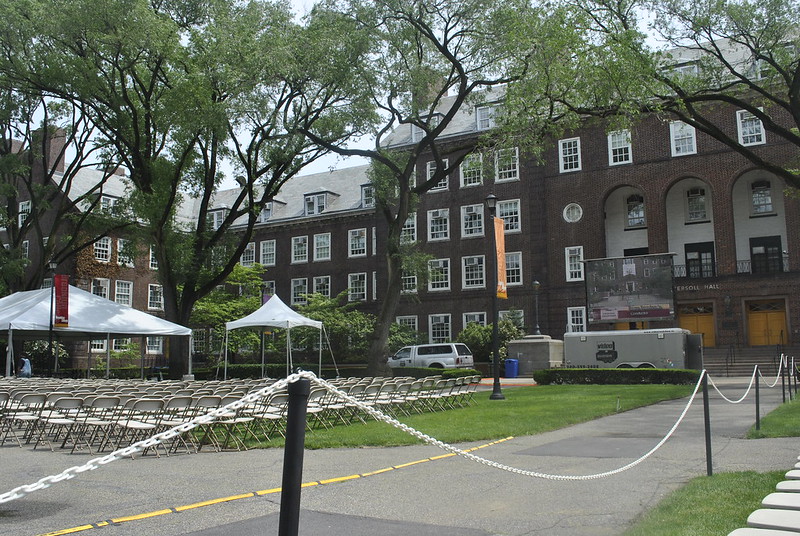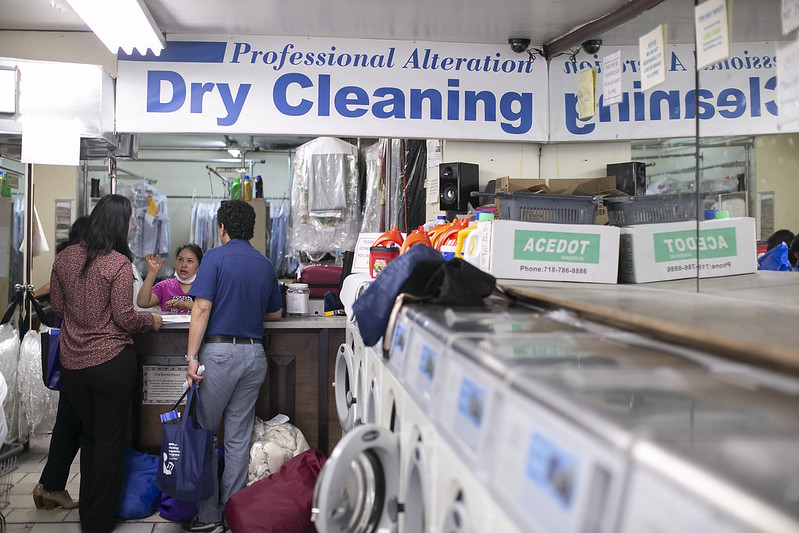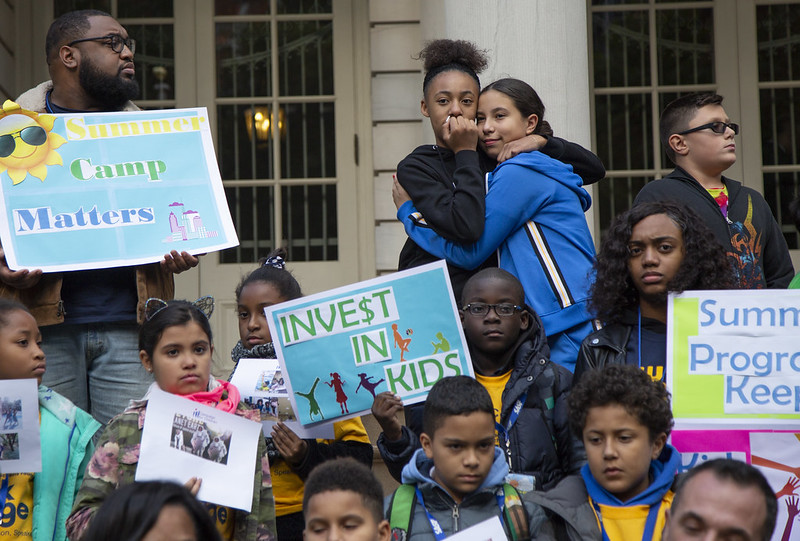Not a Novel Crisis at CUNY

CUNY is closed (photo: Brooklyn College)
What does an educational crisis look like in a plague year? How can I convey, from inside a health emergency, that the City University of New York has been in a slow-burn, decades-long state of crisis? COVID-19 is a matter of life and death, while higher education is not. Yet the COVID-19 pandemic reveals with new urgency, rather than diminishes by comparison, CUNY’s longstanding, systemic failures.
We need to grasp the relationship between this novel coronavirus and CUNY if we want to make a better future for New Yorkers and their city. New York City’s public higher education system and the public health system are connected, each overwhelmed, under-resourced, and fighting for the same tax dollars. They are mirrors of each other, two reflections of a government reneging on its responsibility to the public good, even in the strongest economic times. In the mirror of the virus, which has preyed upon long-standing disparities in our society, we see…
…the State rushing to buy poor CUNY students the technology they need for distance learning now that professors and students cannot meet in person for fear of contagion. But our students needed that technology before COVID-19, and where was the State of New York?
Take a pre-COVID look at CUNY’s campuses and you’ll see that we don’t have printer paper, that our college libraries can’t buy books, and that tenure track faculty can be found in less than half of our classrooms.
We see the unprepared State urgently seeking personal protective equipment and ventilators. At the same time, my college has not had hot water in its restrooms for years, nor decent and affordable food on campus. Black mold, open elevator shafts, and vermin in the halls of CUNY are well documented on social media (see #brokelyncollege, for instance). Just as New York needs short-term healthcare heroics to fight the virus, we need long-term healthcare heroics to make our educational environments safe.
We see with fresh eyes that the State has for decades refused to fund the MTA, the primary source of transit for CUNY’s city-wide commuters. As COVID-19 now makes a ghost ship of the MTA in more affluent neighborhoods and a human petri dish in poorer neighborhoods, are we to forget that for years the State’s slow, dilapidated trains and buses have translated directly into late students, missed classes, lower grades, and unconscionably high dropout rates at CUNY?
In an echo of New York City’s most deadly modern plague, AIDS, COVID-19 is again punishing our most despised, our poorest, most harshly. These are our low-income CUNY students, our precarious Dreamers, our full-time working students with no margin for educational error. Whatever COVID-19 costs, the underclass, black, brown, and ethnic white CUNY community is sure to pay in a special way. We know this from long years of experience.
What the coronavirus brings into startling clarity is that we need to stop using the same threadbare language we’ve long used, perversely, to cast CUNY’s failures as its strengths: “aspiration” (in the face of massive defunding and managed inequity), “social mobility” (for the minority of students who graduate), and our “democratizing mission” (despite constant tuition increases and the ever-widening material disparities between CUNY and rich schools). Metaphors, whether of crisis or hope, will not help us now.
What will happen to CUNY after COVID-19? Beyond dire prediction and revolutionary hope lies a confrontation with the mundane, deeply structural crisis that defines CUNY and public education. The very least we can do is admit that in the years of shortsighted austerity budgeting since the 2008 recession CUNY has managed to become—has been managed to become—less rather than more prepared to meet the current moment.
Governor Cuomo must use the timing of COVID-19 to set a new timeline for CUNY. Before the urgency of the health crisis ends, let tuition at CUNY end. Before COVID-19 kills more of our faculty, let CUNY commit to doubling its full-time, tenure-track faculty and to providing our well-qualified adjuncts clear routes to those new jobs. Before COVID-19 becomes a normalized health disaster, let us disrupt New York’s educational disaster by calling it by that very name. For as CUNY’s 275,000 students and 45,000 instructional faculty and staff know, our crisis is anything but novel.
***
Matt Brim is an associate professor of queer studies at the College of Staten Island, CUNY, and part of the Women's and Gender Studies Faculty, CUNY Graduate Center. His most recent book, Poor Queer Studies: Confronting Elitism in the University, was published in March 2020 by Duke University Press. On Twitter @mattbrimnyc.
***
Have an op-ed idea or submission for Gotham Gazette? Email This email address is being protected from spambots. You need JavaScript enabled to view it.
Expand ‘Right to Counsel’ to Protect Our Families and Small Businesses from Homelessness and Financial Ruin

Small businesses are closed or on the brink across the city (photo: William Alatriste/City Council)
The day after the 90-day moratorium on eviction ends, residential and commercial eviction proceedings will potentially flood our courts, leaving families and small businesses gasping for air.
Amid this pandemic, it is imperative that New York City expands the Right to Counsel law by increasing legal capacity to meet the inevitable COVID-19 eviction demand, and, building on this model, establish a new initiative to provide free legal representation to vulnerable small businesses.
The Right to Counsel law, sponsored in 2017 by City Council Members Mark Levine and Vanessa Gibson, guarantees that low-income families falling below 200% of the federal poverty line have access to free attorneys in housing court. In a show of remarkable success, this law allowed 84 percent of families facing eviction to stay in their homes.
Now more than ever, these protections are critical to preventing homelessness and financial ruin for our residents. Council Members Levine and Gibson are now championing Right to Counsel 2.0, which would increase the income eligibility guidelines to 400% above the federal poverty line, delivering a huge win for tenants.
Adding to these efforts, we need federal and state support for rent relief, and the City Council should increase attorney staffing capacity in each zip code that is currently covered by the law to meet the heightened eviction demand that will follow after the eviction moratorium is lifted. The Council should also expedite the application of the current Right to Counsel law to zip codes where the law is currently not in effect (but slated to be implemented by 2022) to help those families that have had to bear the brunt of the coronavirus.
For instance, zip codes like 10032 and 10040 in Washington Heights, which are not currently receiving representation under the law, have reported high incidences of COVID-19 cases as compared to other neighborhoods of New York City.
Building on the Right to Counsel model, the City Council should employ its budgetary discretion to establish a similar initiative for small business owners. This initiative would fund nonprofit providers to offer comprehensive legal support for qualifying small businesses, particularly in neighborhoods like Washington Heights, Harlem, Elmhurst, Mott Haven, and Kingsbridge.
Nonprofits should be provided funding to assist vulnerable small businesses with free attorneys to negotiate, among other things, new language to their original commercial leases, giving them the greatest protection possible. Here, an attorney’s lease interpretation skills could result in positive outcomes for commercial tenants, such as a rent arrears repayment plan or a shortened contractual obligation period for which they have to pay rent. And if negotiations fail, this initiative would also provide free legal representation for qualifying small businesses in commercial eviction proceedings in court.
Indeed, these proposals have costs — but this is a perfect time for New York City to prioritize long-standing needs of our hard-working families. New Yorkers are counting on policy-makers to be courageous and make bold decisions to steer us in the right direction. We need to get it done.
***
Shaun Abreu is a tenants’ rights attorney and represents low-income tenants covered under the Right to Counsel law in Housing Court. He is a candidate for City Council in Manhattan’s District 7. On Twitter @ShaunAbreu.
***
Have an op-ed idea or submission for Gotham Gazette? Email This email address is being protected from spambots. You need JavaScript enabled to view it.
Mayor De Blasio: Restore Funding to Summer Youth Employment for Teens Who Need It, Like Me

Tens of thousands of young New Yorkers rely on SYEP (photo: John McCarten/City Council)
When I first heard of the New York City Summer Youth Employment Program (SYEP) two years ago, I had just turned 14. I was so excited because that Fall I would enter high school and my family needed money to help pay for my uniform, school supplies, and books. Like a lot of New York families, money was already tight, so the prospect of getting a job where I could help my parents even just a little was an incredible opportunity.
Over the last two summers, SYEP has been a great experience that not only helped me make some money, but also helped prepare me for a better future. Before Mayor de Blasio announced he would be cutting SYEP funding this year as a result of coronavirus, I was already accepted for the summer of 2020, an opportunity I no longer have unless the city undoes that budget cut.
Before SYEP, I wasn’t sure what I wanted to pursue in college and possibly beyond. Then, last summer, I worked at State Farm, which helped me realize how much passion I had for business, finally giving me an idea of what I wanted to study. Through SYEP, I also entered the Work Learn Grow program, which gave me my start working in a social work environment -- a shelter, which completely changed my perspective on life, work, and society.
Through Work Learn Grow, I started working at Praxis Enterprise. Having small parties and celebrations for families living in the shelter brought me joy. Coming into work every day and hearing “Hi Leny! I missed you! Is there after school today?” made me happy. I could have had a bad day but knowing how much I can brighten someone's day - -even through their hardships -- was motivating in a whole new way.
It’s no secret that life for us all under quarantine has been difficult. Not being able to go outside, see my friends, or even go to school has taken a toll on me. I feel for those who have depression like me. I feel for those who are struggling to make ends meet. Sadly, I know I’m not alone. All of which is why I can’t help but think of the tens of thousands of teens just like me who would benefit from having the SYEP now more than ever, especially those whose family members have lost work because of the virus.
For the thousands of parents who don’t have a job, their children could help to fill the void of onerous expenses. Countless families could be saved using SYEP as a way to bring food to the table, transportation money, and to contribute to rent or other household needs.
But SYEP is about so much more than just a summer paycheck. It’s about getting the opportunity for real-world work experience so many thousands of us teens wouldn’t otherwise get. Being in SYEP helped me build my resume, which will help me for years to come as I apply to college and pursue other opportunities. SYEP, even if conducted remotely, still has the enormous potential to help teens like me far into our futures, beyond this summer. Without it, we risk falling much further behind our peers throughout the city.
If our school system of more than 1 million students could convert to remote learning in just a week, then surely there is a way to convert SYEP to provide remote jobs as well. Most students in New York City have electronic devices they can work on, many more so now that the city has been distributing devices for school purposes. This opportunity would be a huge help to the families who lost their main sources of income because of this pandemic.
I hope the mayor and City Council reverse course to help the youth of this city who were counting on summer employment opportunities even before this hard time set in, and need SYEP even more now. We depend on these jobs not just for this summer, but for our futures. Now is not the time to cut SYEP, now is when we need it most.
***
Karleny Ramos is a junior at the High School for Teaching and Professions in the Bronx and a member of Teens Take Charge. On Twitter @TeensTakeCharge.
***
Have an op-ed idea or submission for Gotham Gazette? Email This email address is being protected from spambots. You need JavaScript enabled to view it.




